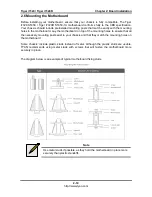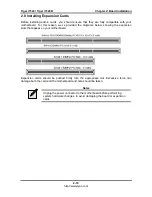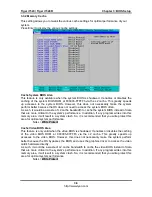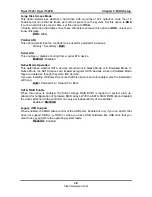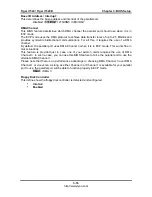
Tiger i7320 / Tiger i7320R Chapter 3: BIOS Setup
3-4
http://www.tyan.com
3.3.1 IDE Master / Slave Setup
Computer detects IDE drive type from drive C to drive F.
Press
Enter
on any of the Master/Slave options to view advanced details of the corresponding
drive.
The system displays advanced details like the number of heads/cylinders/sectors on the
detected disk and the maximum storage capacity of the disk.
This option lets you set the following hard disk parameters:
Multi-Sector Transfers
This option allows you to specify the number of sectors per block for multiple sector transfers.
Disabled / 2 Sectors / 4 Sectors / 8 Sectors /
16 Sectors
LBA Mode Control
Enables or disables LBA Mode.
In LBA Mode, instead of referring to a cylinder, head and sector number, each sector is
instead assigned a unique "sector number". In essence, the sectors are numbered 0, 1, 2, etc.
up to (N-1), where N is the number of sectors on the disk.
In order for LBA to work, it must be supported by the BIOS and operating system, but since it
is also a new way of talking to the hard disk, the disk must support it as well. All newer hard
disks do in fact support LBA, and when auto detected by a BIOS supporting LBA, will be set
up to use that mode.
When LBA is turned on, the BIOS will enable geometry translation. This translation may be
done in the same way that it is done in Extended CHS or large mode, or it may be done using
a different algorithm called LBA-assist translation. The translated geometry is still what is
presented to the operating system for use in Int 13h calls. The difference between LBA and
ECHS is that when using ECHS the BIOS translates the parameters used by these calls from
the translated geometry to the drive's logical geometry. With LBA, it translates from the
translated geometry directly into a logical block (sector) number.
LBA has in recent years become the dominant form of hard disk addressing. Since the 8.4 GB
limit of the Int13h interface was reached, it became impossible to express the geometry of
large hard disks using cylinder, head and sector numbers, translated or not, while remaining
below the Int13h limits of 1,024 cylinders, 256 heads and 63 sectors. Therefore, modern



